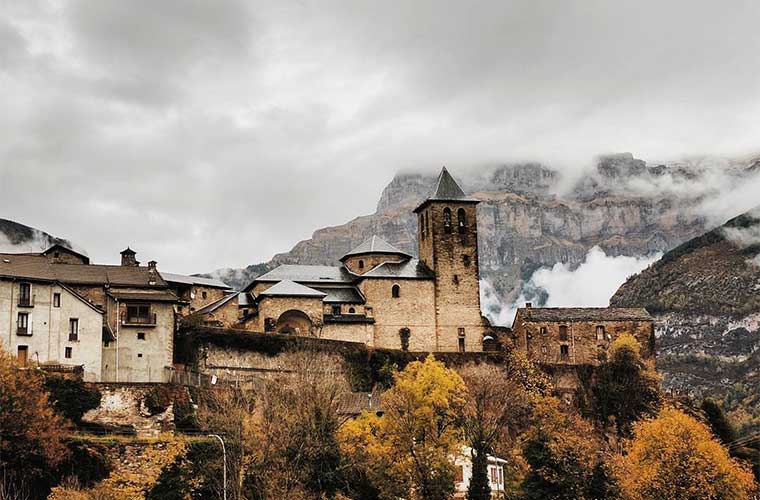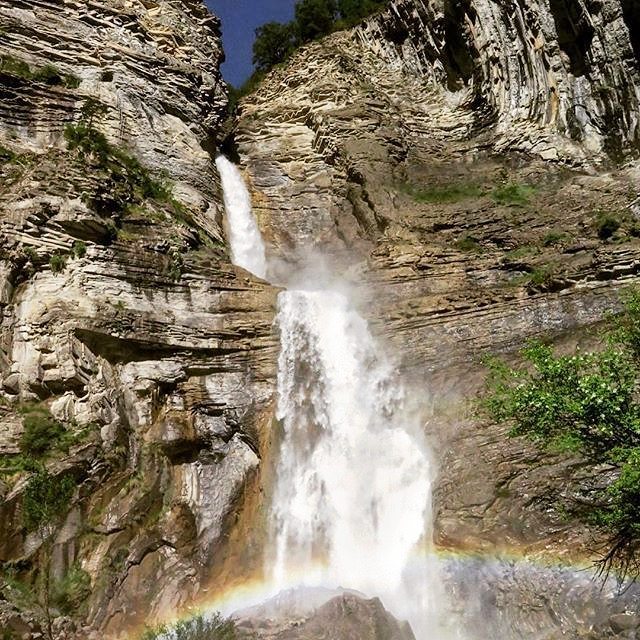The villages of Ordesa y Monte Perdido National Park

A journey through the villages of the Ordesa and Monte Perdido valley: Torla, Broto, Oto, Buesa, Sarvisé, Fiscal, Boltaña and Aínsa.
Torla, the gateway to Ordesa

This town is the gateway to the Ordesa valley and to the well-known and beautiful route Horsetail. It is a beautiful village surrounded by steep peaks of more than 2,000 metres and situated on the right bank of the Ara river. Its beautiful stone alleys, flower-filled balconies and 16th century church form an idyllic picture postcard image.
Torla is mainly characterised by the large number of hills that surround it, not forgetting the great amount of history it possesses. From medieval originIt has survived the passing of the centuries with excellent preservation to the present day, and this can be seen in the fantastic state of the streets and houses of the town. The reason for its fame lies in the fact that it is considered to be the gateway to the Ordesa y Monte Perdido National Parkbecause this is where the bus which leads curious tourists to enjoy an unforgettable experience in this natural wonder. Many of them end up staying in its hostels.
READ ALSO: Ideas for spending the December long weekend in the Aragonese Pyrenees".
The natural beauty of Torla will make you forget all your problems, with its lush landscapes and the peace and harmony of its inhabitants.
Even with all that peace, many tourists come hoping for a good time, and they may not be far wrong: you'll be able to do activities in the water (like the rafting) and alpine sports (such as skiing, snowshoeing, skiing walking and cycling routes and climbs). The geographical situation of Torla is very convenient, as you can choose the size of the mountain you want to go to, like a difficulty regulator.
Thus, we recommend the most inexperienced climbers to opt for the routes in the medium-sized mountains and the more experienced ones to try climbing one of the larger and more imposing ones. You can have fun on family The older ones can enjoy climbing or hiking, while the younger ones can stay and admire the beautiful landscapes that populate the area.
Broto, and its Sorrosal Waterfall

If we continue downstream for 20 kilometres we reach the beautiful Broto, which gives its name to its own valley. Discover its historic quarter with its traditional architecture and stone houses, such as the Casa del Valle or the old prison. If we cross the Ara river We will enjoy unequalled views and just a few minutes away from the town we will find the beautiful Sorrosal waterfall, 80-metre drop with light blue pools.
Oto
We only have to walk a couple of kilometres to reach this beautiful village of particular charm. Its traditional architecture is magnificently preserved and strolling through its narrow streets is a real delight. It has a defensive tower, the Don Jorge HouseThe church tower and the 16th century church tower.
Buesa
We will return to Broto to resume the national 260 and take the turn-off to the village of Buesa. Once here, enjoy its peaceful character and its beautiful views, with a complete panoramic view of the valley, as it is situated in its upper part, which makes it a lookout village.
Sarvisé, a wonder of the Broto Valley

Sarviséa small town located in the Broto Valleyis located in the small but well-known Sobrarbe regionIt has dreamlike landscapes. The few inhabitants of this village are dedicated, even though they have a livestock tradition, entirely to feeding the tourist services of the whole area. You will be able to see both beautiful mountains and extensive and mysterious forests in a region that stands out for its particular beauty.
This small village is presided over by a beautiful Romanesque church that will leave you fascinated. Also, when you arrive you will be struck by the presence of slender and stylised horses, as it is a magnificent place for horse riding along the river. Broto valley. If you continue along a narrow road you will reach the famous Vió Valley and the Añisclo Canyon as well as the nearby town of Poza de ChateIt is an ideal spot for a good swim in its crystal clear waters.
If you love food and gastronomySavisé offers refined yet traditional dishes, which will give you an unprecedented gastronomic pleasure, thanks to the possibility of staying in picturesque and peaceful rural houses.
Lastly, the riding a horse is a widespread tradition in the area and is therefore also a tourist attraction that appeals to young and old alike. Its proximity to the National Park of Ordesa and Monte Perdido make it an unrivalled holiday destination.
Fiscal, and the Ara valley

If you want to enjoy the Aragonese Pyrenees and don't know where to go, we highly recommend you visit the small town of Fiscal in Huesca. It has a sublime geographical location, given its proximity to the Pyrenees and the Ordesa National ParkThis has brought it many foreign visitors every year.
In this village we will make a stop to contemplate the beautiful views from the bridge over the river Ara river, that preside over the landscape with a superb presence. Crossing this we will reach the historic quarter, with its beautiful houses, its hermitage of San Salvadorits Fiscal Tower or the Batán de Lacort among many other attractions worth seeing.
The village is notable for its large church with a central apse that is very iconic in these structures. It also has a square tower with battlements. Pictures and paintings from the 17th and 18th centuries populate the interior of this church. Other attractions are the large and populated landscapes, based mainly on forests of tall pine trees and lush flowers, as well as its streets, with a gothic appearance worthy of admiration.
Boltaña
Before arriving at the next village we can enjoy the viewpoint of Jánovasa veritable balcony overlooking the river Ara and the abandoned village of Jánovas. Then we arrived at Boltaña, one of the most beautiful villages in the whole park. You can stroll through its magnificently preserved historic centre, its beautiful stately houses built in stone, its squares and narrow streets. Don't forget to climb up to the ruins of the Castle of the Counts of Sobrarbe to enjoy a perfect panoramic view.
Aínsa, living history

AínsaWe are almost at the end of the route, in one of the most visited villages in the park and considered one of the most beautiful in Spain. Wander through its narrow streets, stroll through its walled old town, contemplate its churches as well as the Santa Maria or the Covered Crossvisit its main square and its castle. From its viewpoints you can also enjoy the views of the Mediano reservoir.
The town of L'Aínsatraditionally treated as the great capital of the former Kingdom of SobrarbeIt was not until well into the tenth century that it finally entered the Aragonese community. This population is really loaded with historyThe main reason for this was religious disputes.
There is a lot to see in this town, although we can highlight several locations:
- Religious sites such as the Church and the Tower. This building was built to honour Santa Mariahas an architecture that is completely Romanesque and has the structure common to churches of this style: a single nave with a large central vault, elevations in some parts and a semicircular apse at the front. What is particularly peculiar about this church, however, is what is not visible to the naked eye: a curious crypt extends under the building itself. In addition, it also has the "OIL ROOM"The apse is a small room located just south of the apse itself.
- The tower is located at the base of the church itself. It is so high that it represents one of the few points that offer an approximate guide for users who do not know the area and have to use a map. Both the church and the tower itself were built around the 12th century.
- The CastleThe military building is located in the immediate vicinity of the other military buildings, which may date from around the 11th century.
Aínsa, as we have seen, is a town with a large number of emblematic buildings, but it also offers the peace and tranquillity necessary for strolling in communion with nature. Its town planning is very common in the villages in the area, with a large place in the centreThe market square, which also serves as a market, has only two connecting streets. The housing architectureThe most notable feature of the older ones is that they contain pointed windows or semicircular arches.
Fastpacking is not about going faster. It's about going lighter.
If you come from classic trekking, this is the next step: learning to move with less weight,
more fluid and enjoying every kilometre more.
Join the channel and start discovering what lightness feels like.
